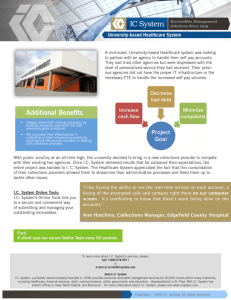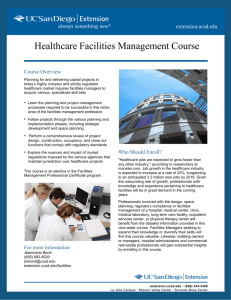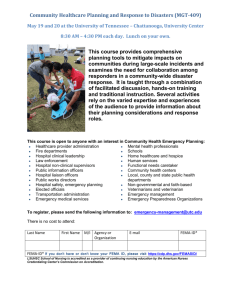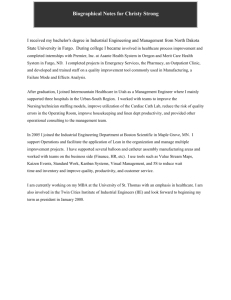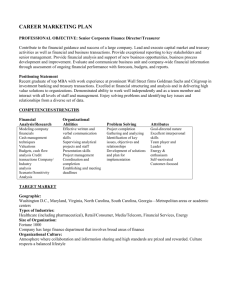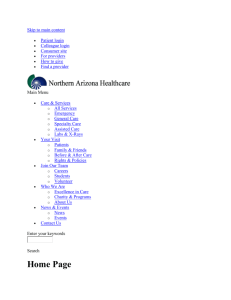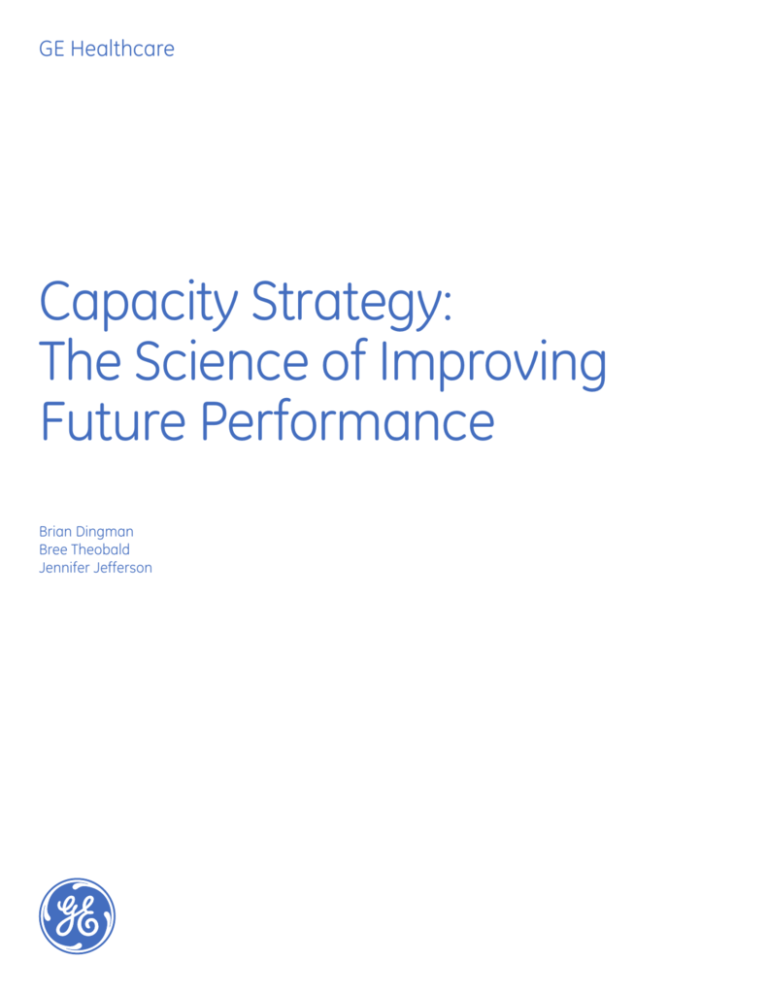
GE Healthcare
Capacity Strategy:
The Science of Improving
Future Performance
Brian Dingman
Bree Theobald
Jennifer Jefferson
Developing strategic plans that are well-vetted against the
In these uncertain times, planning
inherent variability associated with healthcare delivery is
for the future is more difficult than
critical to success along with the ability to sustain management
control over future performance. Developing multiple likely
ever. This is particularly applicable
capacity scenarios that can take into account the dynamic
to the U.S. healthcare industry.
interdependencies of a system across a range of future states
Nearly 100% of hospitals and health can help strategies such as these withstand the test of time.
systems are executing strategies to Controlling variability to manage
lower cost while improving quality of the unknown
care delivered. Most experts would
Operational capacity in healthcare is a measure of how well
agree that among the priorities that a hospital or health system manages its resources—physical
space, infrastructure, staff, equipment, and support services—
rise to the top of any cost-reduction in order to provide patient care. A system not designed
intentionally for capacity optimization will evolve on its own—
platform is increased operational
and not in a good way.
efficiency. However, many of the
Ideally, a hospital should be able to operate efficiently in the
organizations grappling with this
85% to 90% capacity range. However, studies show that without
challenge fail to recognize the
a strategic approach to capacity management, hospitals with
bed occupancy rates exceeding 85% can expect regular bed
impact that inadequate capacity
shortages, periodic bed crises, and difficulty in providing timely
management can have. Much of
access to care. Conversely, hospitals operating at 85% capacity
or lower are not using their existing capabilities efficiently and
the struggle stems from reactive
management of patient flow rather thus operate at a higher cost per patient day.
than a proactive approach, along
Although the ideal target for operational capacity is different
for every organization, the key to achieving it is the same—
with a lack of understanding how
reducing unwanted, controllable variation in care delivery to
changes in one area impact another. avoid the swings in utilization that stress the organization
and impede its ability to manage access, quality, and cost.
Without a formal strategy for
maximizing capacity, it is difficult to Controllable variations are distinct from random variability,
quantify and prioritize the initiatives which accounts for factors such as the volume of patients in
the ER on a given night (although that, too, can be predicted
that will have the greatest impact in with a great degree of accuracy). Variation within the control
of the organization reflects the outcomes of deliberate
taking cost out of a system.
1,2
operational decisions such as the days on which elective
surgeries are performed or how patients are scheduled
and prepared for discharge.
When operational decisions are made without an
understanding of the system dynamics and interdependencies
within a hospital, capacity problems arise. If 80% of a hospital’s
elective surgeries are scheduled in the middle of the week,
then the PACU, ICU, and the inpatient units will likely suffer
the effects of capacity overload on Tuesday, Wednesday, and
Thursday. A flood of emergent surgeries on those days would
likely be a real tipping point into gridlock. If patient discharges
are not managed aggressively and left to happen “midafternoon sometime,” the backlog of rooms to be cleaned and
put back into the system will result in long wait times for ED
patients or admissions from other sources in the community
who have been waiting for a bed.
Capacity issues also occur when operational decisions are
not aligned to organizational goals. For example, a hospital
with the strategic intent of becoming an orthopedic center
of excellence almost had its efforts derailed by the failure to
think through and plan for the housewide ramifications of its
growth plans. This facility brought additional ortho specialists
onboard, ramped up marketing, and experienced a rapid influx
of new patients. Early success exposed the lack of capacity
planning: Overwhelming demand led to long lead times
for appointments; there was no room on the surgical block
schedule for the new surgeons; and wait times for a bed in the
ortho unit often stretched to greater than six hours for patients
waiting in the PACU or ED.
Whether planning for future growth or trying to reduce
congestion and operate at higher utilization, healthcare
organizations need strategies for operationalizing care delivery
on a systemwide basis rather than by department, service line,
or care area. Articulating an effective capacity strategy is a
powerful lever that can help a healthcare organization:
• Control costs—Right-sizing capacity in use gives an
organization better control over the sources’ variation. For
example, one of the largest expenses for a hospital is labor.
Improved capacity management reduces the need for flex
staffing to cover swings in demand and census.
• Grow patient volume and revenue—Service line growth
targets can be realized more effectively with implementation
strategies that are built with a clear understanding of
the likely effects on capacity utilization throughout the
organization. Smoothing out peaks in demand and reducing
patient flow congestion can yield an increase in throughput,
opening the doors to latent demand and recapturing
patients who have gone elsewhere due to long wait times for
appointments or admissions.
• Improve patient, physician, and staff satisfaction—A
healthcare delivery system that functions with less congestion
reduces the stress level for all stakeholders, improving the
care experience for the patient and the day-to-day work
environment for caregivers.
Understanding the demand profile
Understanding the supply and demand dynamics that affect
utilization is the first step in creating an effective approach
to capacity management. Capacity strategies developed in
the absence of this basic understanding will likely fail or be
unsustainable.
Demand for capacity at any unit level within the hospital can be
made up of several different patient types or segments. Each
patient flow segment can have a distinctly different demand
timing and capacity requirement. Understanding how these
various segments of the patient population aggregate to form
the overall demand profile and daily capacity requirements
is the key to forming an effective capacity strategy and is the
basis for managing capacity utilization in such a dynamic
environment.
An ideal capacity management system is aware of these
critical dynamic relationships between segments of the
patient population and more fully considers the potential
consequences for the system of planned changes to demand
volume or mix.
The value of system-level modeling
In working with clients to help them create and deploy
effective capacity strategies, our approach is to optimize
current capacity utilization and springboard from that strong
foundation to devise and implement approaches that will
transform the organization.
We begin by developing a comprehensive set of models that
provide this system-level view of the complex demand mix
that affects capacity usage for the healthcare system. These
models provide the baseline for understanding how the
dynamics of this particular system are created and where the
multiple sources of variation originate. Combining these system
behavior insights with in-depth discussions with the hospital
leadership on future strategic capacity goals, the models are
then used to test potential strategies for achieving long-term
capacity strategy objectives.
Capacity strategy in action
Hospital A. A 190-bed hospital in the Midwestern United States
was challenged by capacity bottlenecks in the emergency
department and congestion on inpatient units, exacerbated by
a 10% growth spurt in patient volume. In advance of building
a new patient care tower, the hospital engaged GE Healthcare
Performance Solutions to take a scientific approach in
determining a new capacity strategy, with the following goals
in mind:
• Provide the right level of care for each patient
• Allow for more predictable staffing
• Increase staff/physician/patient satisfaction
• Lower operating costs
Dynamic simulation was used to model the impact of changes
to capacity, length of stay, and case mix on congestion and
utilization of a unit. In partnership with the hospital’s executive
leadership team, more than 14 different capacity management
scenarios were tested, iterated, and refined before arriving at
a strategy that met the hospital’s goals. The principal change
was a definitive segmentation of inpatient units by levels of
care, including the designation of a progressive care unit with
the flexibility to care for higher-acuity patients and a short
stay unit for quicker turnaround of patients needing little
intervention. These changes enabled the hospital to recognize
more than $750,000 in financial benefit from both cost savings
and incremental revenue due to additional direct admits.
Hospital B. This 700-bed hospital in the southern United States
wanted to find new strategies for managing patient flow. Even
when operating at less than 80% capacity, the facility “felt”
full and care delivery was slowed. Working with GE Healthcare
Performance Solutions, the executive team examined existing
operations, looking at utilization metrics by care area and
service line, market factors, and historical demand. This
assessment revealed both constraints and opportunities for
growth. Among the key findings:
• T he facility would have to grow admissions by more than
10% to exceed 80% occupancy with its existing operational
capacity—a goal that seemed unlikely, given trends
in admissions.
• Care operations were hampered by a high degree of artificial
variability. This variation was driving a misalignment of supply
and demand on a daily basis that manifested in congested
patient flow. For example, the volume of OR admissions for
elective surgeries varied significantly from day to day, causing
drastic swings in the inpatient census that affected capacity
in the ICU, the ED, and inpatient units.
The team developed four capacity scenarios to test, each
one projecting a different rate of volume growth: significant,
modest, no growth, and negative growth. These scenarios were
validated and tested via GE’s dynamic simulation tools, and
iterated through dialogue and working sessions with executive
stakeholders. The team selected a modest growth (+2%)
capacity strategy that called for shuttering two or three units;
implementing OR scheduling changes to reduce variability and
expand capacity in high growth areas such as neurosurgery;
and aggressively managing discharge processes to reduce
overall length of stay (LOS). The models forecast 80% to 85%
capacity utilization and $13M to $17M in potential cost
savings resulting from an increase in OR cases, reduced LOS,
and the closing or reassignment of underperforming units.
Governance: Preventing variation
from creeping back into the system
A critical aspect of capacity
transformation is governance—the
organizational structures, policies and
procedures, committees, and metrics
through which activity is measured,
change is managed, and decisions are
made. Governance is where operational
factors intersect with the political and
cultural factors that exist in every
organization. An effective and wellintegrated governance structure relative
to capacity management enables
decisions at every level that are datadriven, transparent, and aligned with the
goals of the organization. This requires
that leaders have access to a global view
of hospital operations—one capable of
synthesis for key indicators such that
variations can be identified and dealt
with in a timely manner.
Authors
Brian Dingman is an Intellectual Property Manager supporting the development and application of computer
models to improve system design and analysis. Brian has more than fifteen years of experience developing and
applying innovative, operational research computer models to design and improve business systems.
Brian has developed and applied innovative solutions for healthcare delivery systems, including scheduling
and patient flow simulation models for oncology clinics, emergency departments, and perioperative services.
Bree Theobald is a Consulting Manager in GE Healthcare’s Performance Solutions team with six years of
engineering and consulting expertise.
She has led ten clients across the United States, applying Six Sigma and Lean expertise to streamline hospital
patient flow in a variety of domains: operating room, emergency department, inpatient units, laboratory services,
and outpatient oncology clinics.
Jennifer Jefferson is Managing Principal in the Clinical Operations practice, a professional services organization
focused on enabling healthcare organizations to deliver safe, more efficient patient care. In her role, she is
responsible for developing the strategy, organization structure, staffing, and execution of engagements with
Clinical Operations’ clients. She focuses on improving utilization of healthcare capacity by delivering solutions
that predictably reduce congestion and lead to lower cost and a better patient experience.
Mountain D., Fatovich D, McCarthy S. Myths of ideal hospital occupancy.
Med J Aust. 2010;193(1):61-62.
2
Bagust A, Place M, Posnet JW. Dynamics of bed use in accommodating emergency
admissions: stochastic simulation model. BMJ. 1999;319(7203):155-158.
1
GE Healthcare
3000 North Grandview Blvd.
Waukesha, WI 53188
U.S.A.
©2012 General Electric Company – All rights reserved.
GE and GE Monogram are trademarks of General Electric Company.
GE Healthcare, a division of General Electric Company
www.gehealthcare.com
PS-US-BR109-11.12

